Visting the sites of "Breaking Stone"
I have spent the last few days in Buxton firstly visiting Dad and secondly visiting the locations featured in our book “Breaking Stone”, which I had read about but not previously seen. We also went on a tour of local bookshops to see if we could interest them in taking any copies. The rest of the time has been spent trying to avoid the rain and sampling local food and drink products, including the excellent Buxton Gin. The rain, which has been a near constant drizzle, I have mixed feelings about. The lower temperatures of between 13 and 19 C have meant that I could actually enjoy a few nights of undisrupted sleep , compared to the 30 degree plus night time temperatures that I left behind in Milan. On the other hand my shoes and feet have felt wet and cold for the while time, I was in Buxton.
On Wednesday morning, we set of for a look at the first of the two camps featured in “Breaking Stone” at Peak Dale, Derbyshire. The weather was grey, with a low drizzle and very damp under foot. We arrive at Christ Church, Peak Dale. Eighteen of the German prisoners who died in the 1918-19 Influenza Pandemic were originally buried in this cemetery. In 1961, their mortal remains were exhumed from Peak Dale and taken for reburial the German War Cemetery in Cannock Chase. There is no monument to the prisoners at the church; however, we were interested if we could work out where the original burial site was. There is a large area of empty ground on the right hand side of the cemetery. There are some older graves in this section of the graveyard, with some more modern ones on the other side. The area certainly looks big enough to have once been the site of 18 graves.
 The empty spaces at Peak Dale Graveyard
The empty spaces at Peak Dale Graveyard
One notable grave is that of local soldier Private Yates who died of illness before reaching the front. Some of the German prisoners from the Peak Dale camp attended his funeral service.
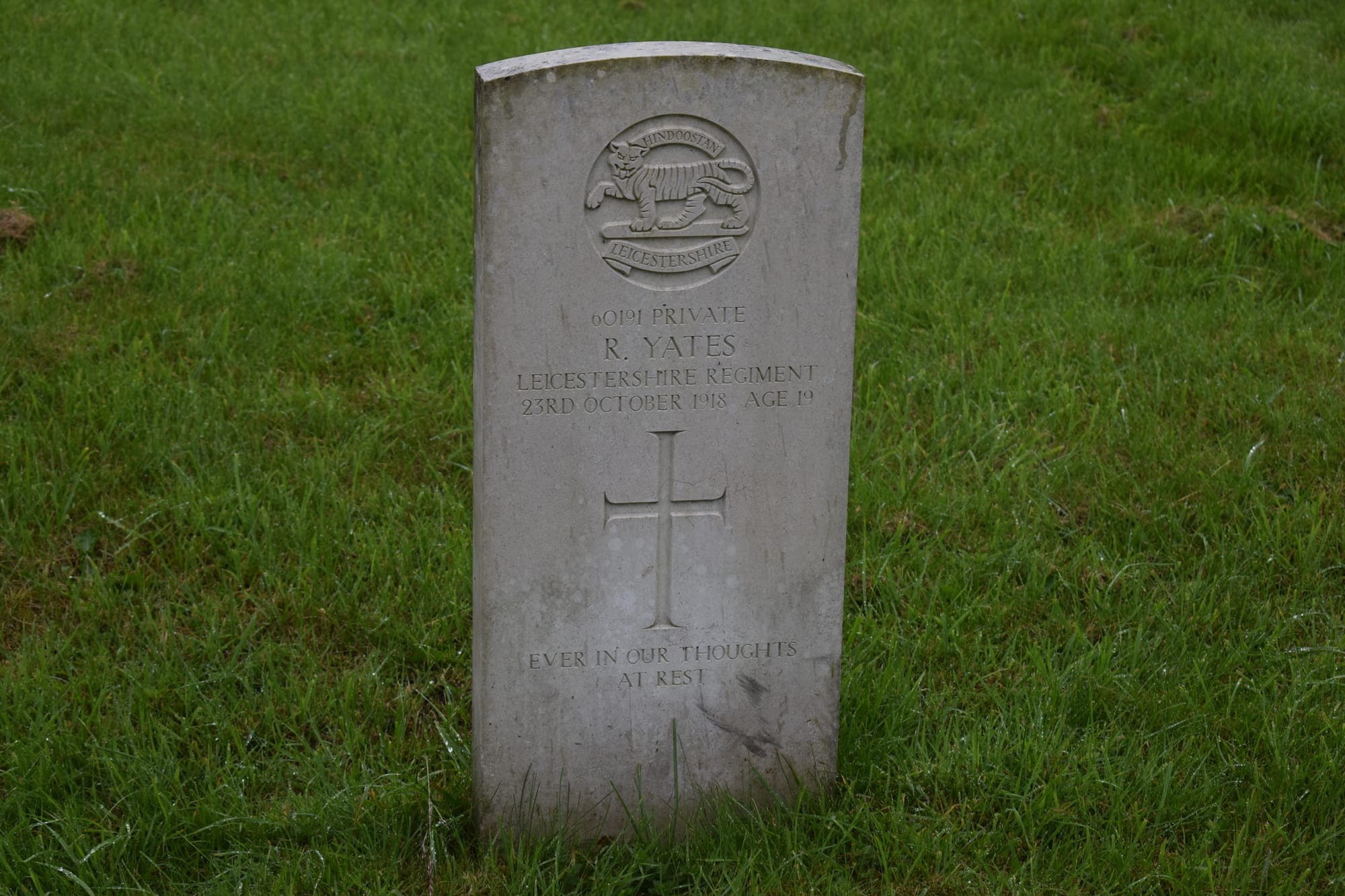 The grave of Private Yates
The grave of Private Yates
If anybody from Peak Dale has any knowledge of where the original burials were that or indeed any recollections of the exhumation in the 1960s, we would be very interested to know. Incidentally, Christ Church, Peak Dale is now no longer in use as a Church and is up for sale. It looks like that with a fair amount of renovation; it would make an interesting residence.
Walking away from the Church on School Road, we pass the large and well-maintained bowling green and arrive at Batham Gate Road. From here, a Public footpath leads across what was the site of the Peak Dale Camp. It is now used for pasture and you can no longer see anything remaining of the camp; however, it has never been developed and the boundaries of the field are still the same as the camp. The camp was located right at the top of the quarry face. Today this is understandably fenced off for safety purposes, with a thick growth of hedge shielding the quarry face (and the drop down) from view.
 Boundary of Peak Dale Camp looking over quarry face
Boundary of Peak Dale Camp looking over quarry face
We assume that the prisoners used to walk out of the main gate of the camp and down the hill (Batham Gate Road) to the quarry entrance at the foot of the hill. The original quarry office is still there, it appears to be now in use as a small factory/ distributor of novelty goods. The architect of the building was one George Garlick, responsible for a number of industrial buildings in the area. This appears t be one of the only surviving examples of his work, interestingly, for a fairly drab and utilitarian industrial building he has used a three dimensional frieze just below the roof, somewhat reminiscent of the sort of thing you see on Egyptian temples. Please forgive me if there is rather more technical architectural term for this.
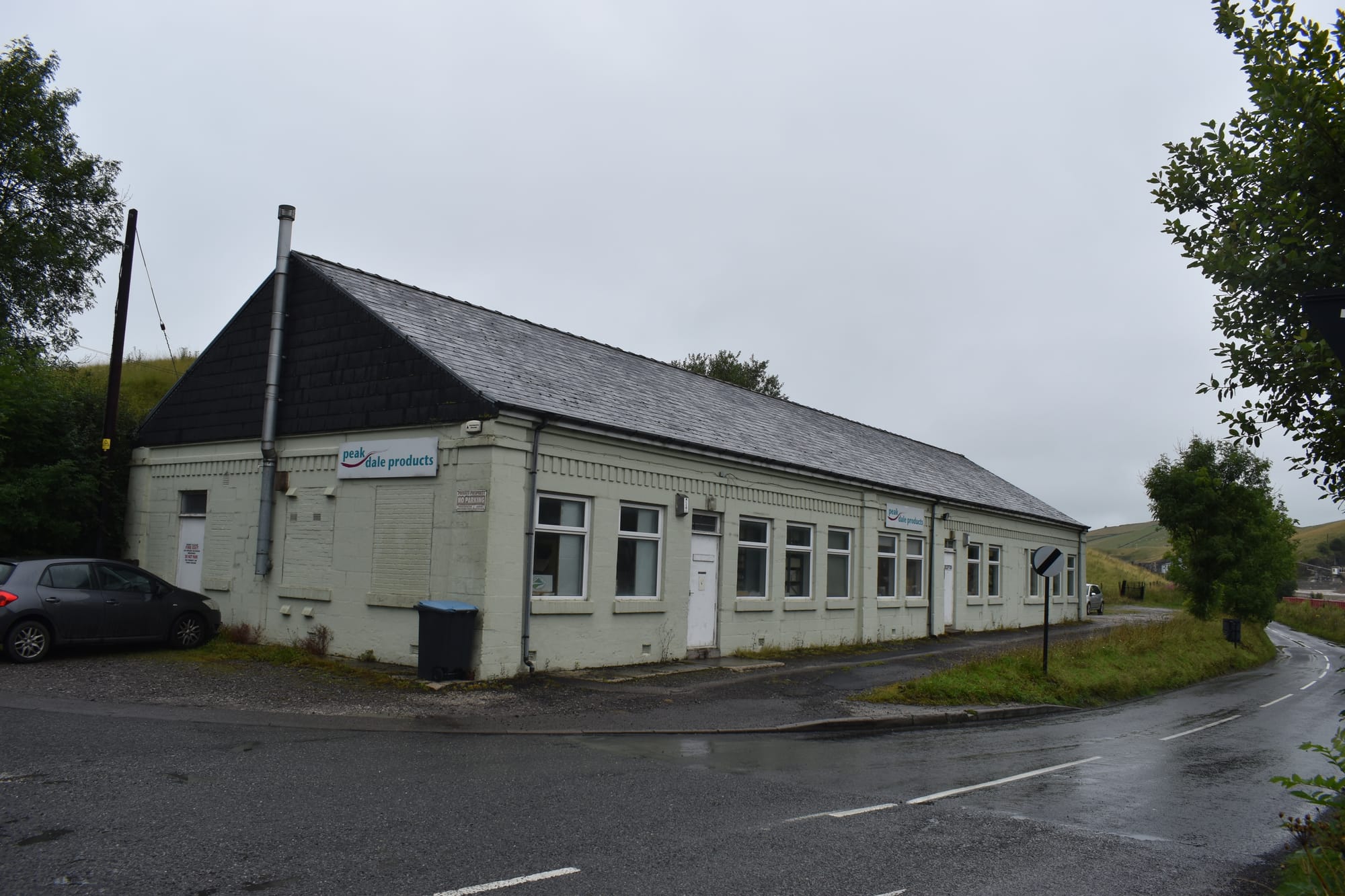 The quarry office
The quarry office
Across the road from the quarry one are a railway bridge and Peak Dale Station. This is now used for shipping local limestone products far and wide. In one of those small ironies of life, DB Schenker (part of the Deutsche Bundsebahn Group) now operates the station.
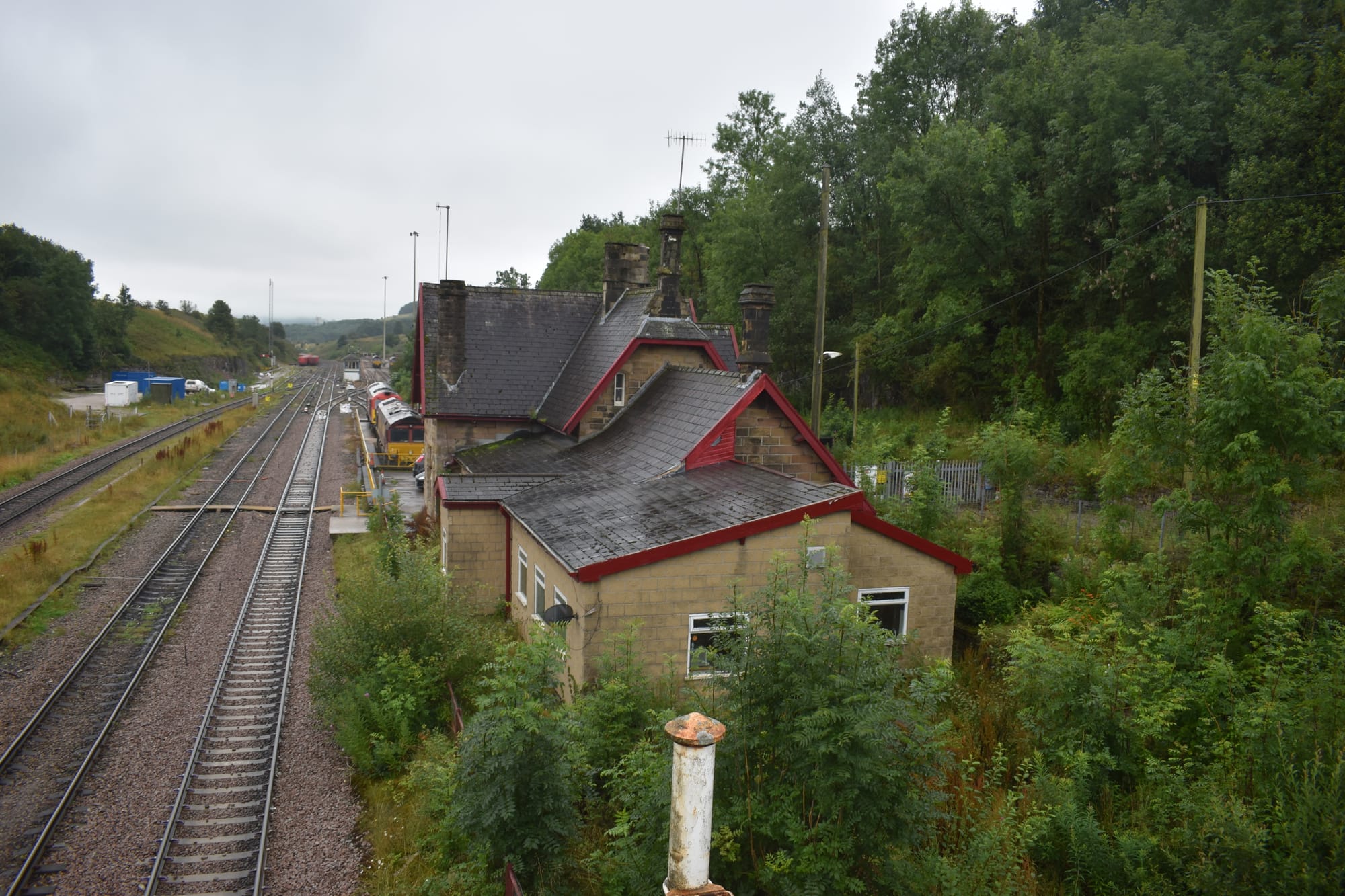 Peak Dale Station
Peak Dale Station
I think that is quite a nice touch. 100 years after German POWs worked the quarries; the German national train company is now responsible for moving huge trains of limestone products from the very same place: That seems like peaceful progress to me. I walk up the hill again to try to take some photos of the quarry face; this proves to be very difficult with the verdant foliage and the fact that I am avoiding the traffic hurtling up and down the narrow road. The lighting conditions are not good. Anyway, I did my best for a photo. Even with all the quarrying activity around, the Peak Dale Camp and the quarry seem peaceful. A small stone quarry in an idyllic rural setting, one can only imagine what a break that was for the German prisoners from the carnage and horror on the Western Front.
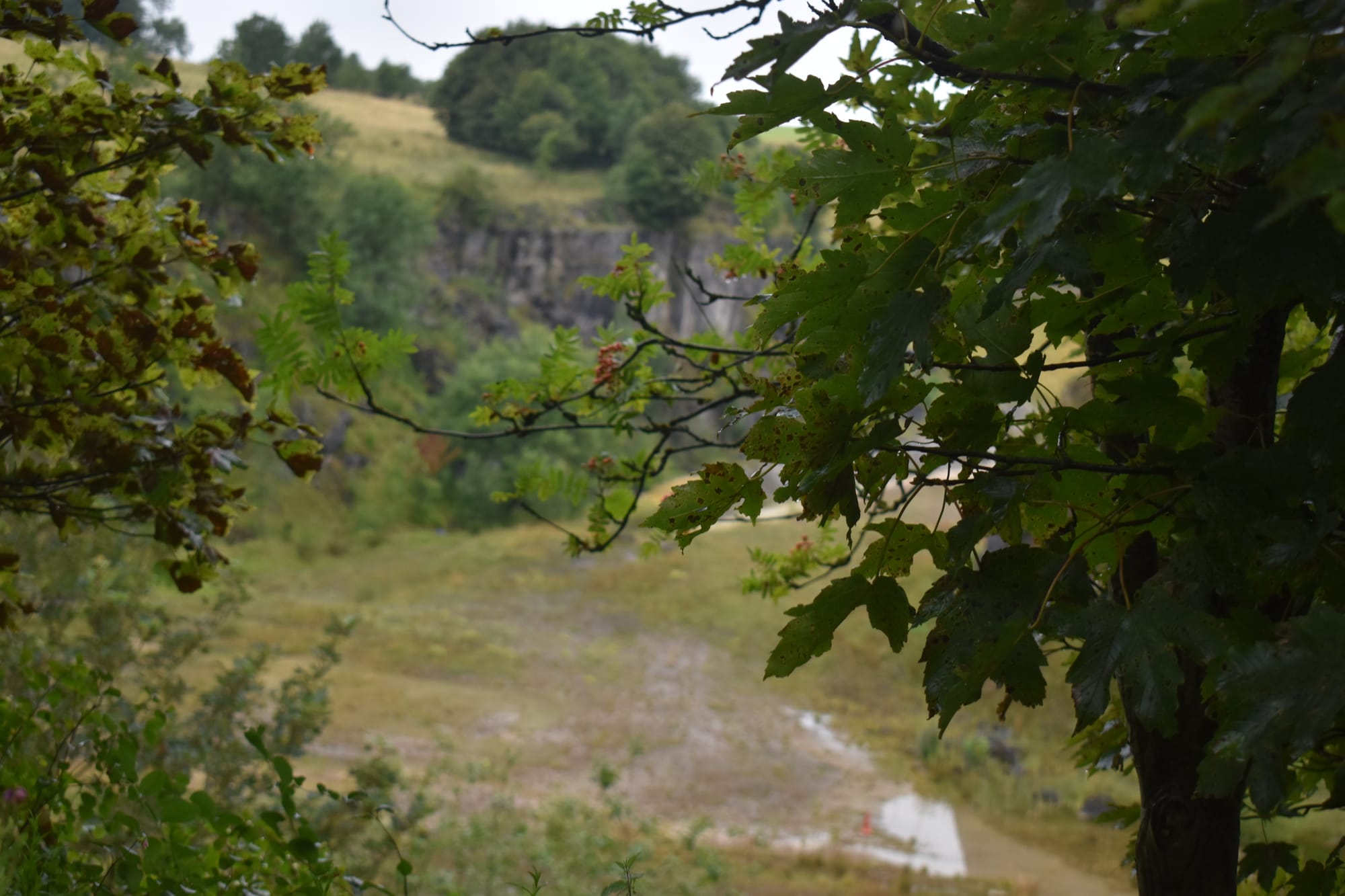 The quarry
The quarry
In the afternoon, we move on to the more practical side of self-publishing. We go out to High Peak Bookstore and Cafe at Brierlow Bar, just outside Buxton. Here a very helpful lady takes eight copies of the book; she even orders another six copies of one of father’s previous works “The Turnpikes of Buxton”, which has apparently been selling well. Buxton Books is a fine and spacious bookshop, with a café and a as far as my brief browsing allowed, a good selection of Military History, Art and Travel books. A place you can cheerfully browse for extended periods and come out with a number of purchases- just because they caught your eye. Hats off to them for running a successful independent bookshop in a place not many people would expect to find it.
On Thursday, the weather looked a little brighter, although my shoes have not really dried out from the day before. We set off to have a look for two sites in Cannock Chase the reconstructed First World War Hut and the German War Cemetery. Cannock Chase in Staffordshire proves to be about 50 minutes’ drive from Buxton. A journey most notable for a striking series of sculptures on roundabouts in Uttoxeter. These include, for some reason, a giant Bull-, which leaves me pondering on whether Uttoxeter is some hitherto unknown outpost of Minoan Civilisation in Staffordshire. Cannock Chase is beautiful, with its mixture of deciduous and evergreen woods; it is reminiscent of parts of Sherwood Forest. You could almost imagine Robin Hood and his Merry Men or Ivanhoe wandering around here as well. Beautiful though it is , all the roads look fairly similar and the GPS seems to be playing up a bit, and although it is signposted ( rather obscurely) we end up overshooting the road for the German War Cemetery and going round in a rather large circle.
By happy coincidence, this rather large circle takes to the Cannock Chase Information Centre and the First World War Hut, so although it was on our agenda we find it almost by accident. The First World War Hut, used to be a Parish Hall and was dismantled and reassembled in Cannock Chase. This reminds us that substantial areas of Cannock Chase were given over to an Army training camp, including accurate full-scale reconstructions of trench systems, as found on the Western Front. In 1917, parts of Brocton Camp were sectioned off to create a Prisoner of War Camp for hundreds of German Prisoners arriving from the battlefields in France and Belgium. In fact, Brocton POW camp was the administrative centre, which controlled the satellite camps at Peak Dale and Ladmanlow. The hut probably is not exactly the same as the type used at the two prison camps, but as a standard War office pattern it provides a good impression of what the camp huts might have looked like. The model is referred to as the Type 19 Hut and is about 100 ft. long by 20 ft. wide. It is s constructed on raised concrete or brick pillars, it looks like the side walls (including window frames) were prepared in sections elsewhere and then put together on site. Presumably, the raised construction made it easier to site the huts on uneven surfaces and we would imagine made attempts at tunnelling out of the hut more difficult. The hut at Cannock Chase was used for British & Empire Regiments training at Cannock chase, and forms part of an itinerary following the locations of New Zealand Regiments in the First World War. Unfortunately, the inside is open by appointment only but the outside gives a good impression of what the prison huts looked like and from the specifications given in the auction sales of 1919 and 1930 for the Peak Dale and Ladmanlow Camps, we can assume they were very similar, albeit different in measurements.
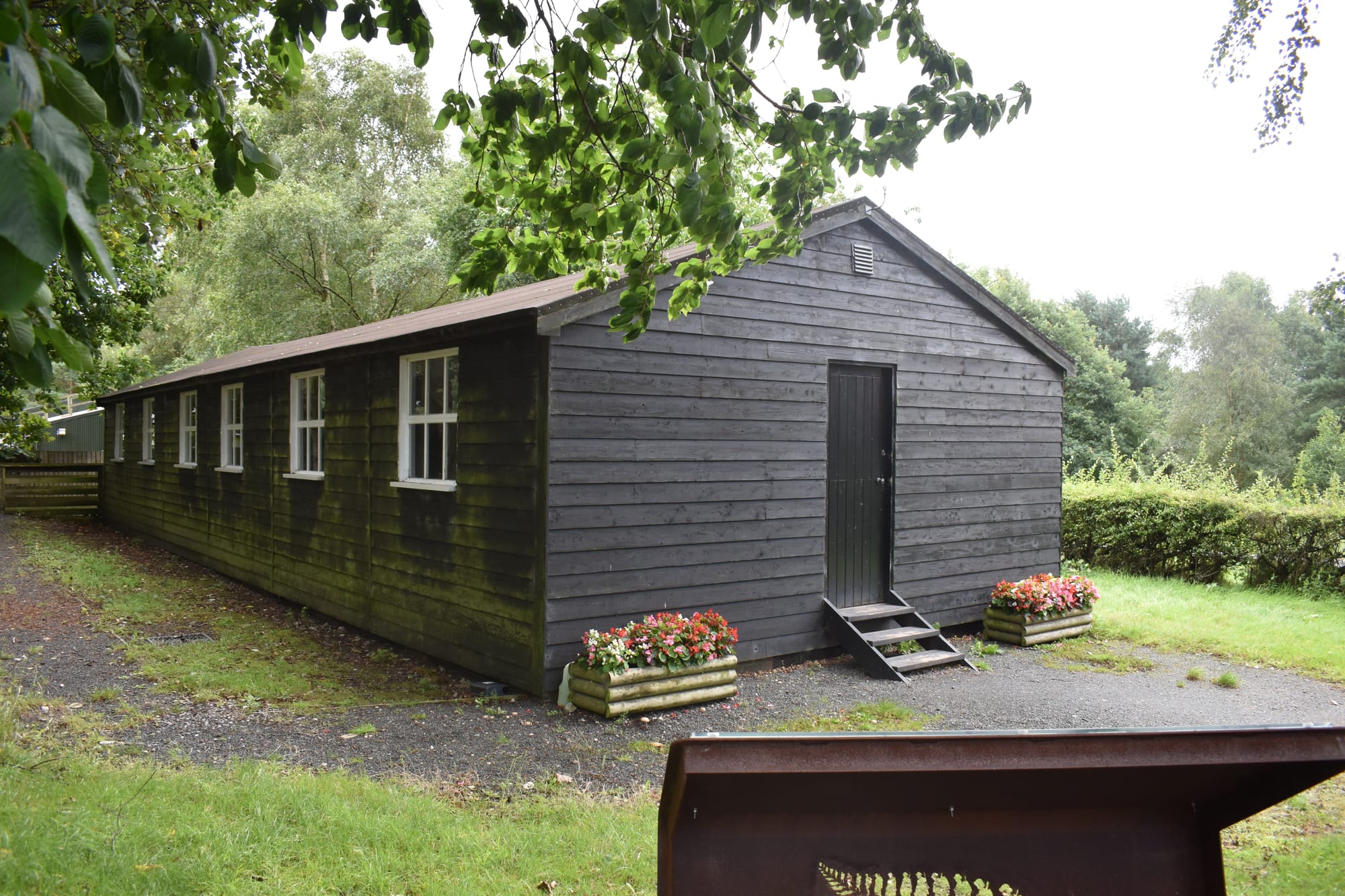
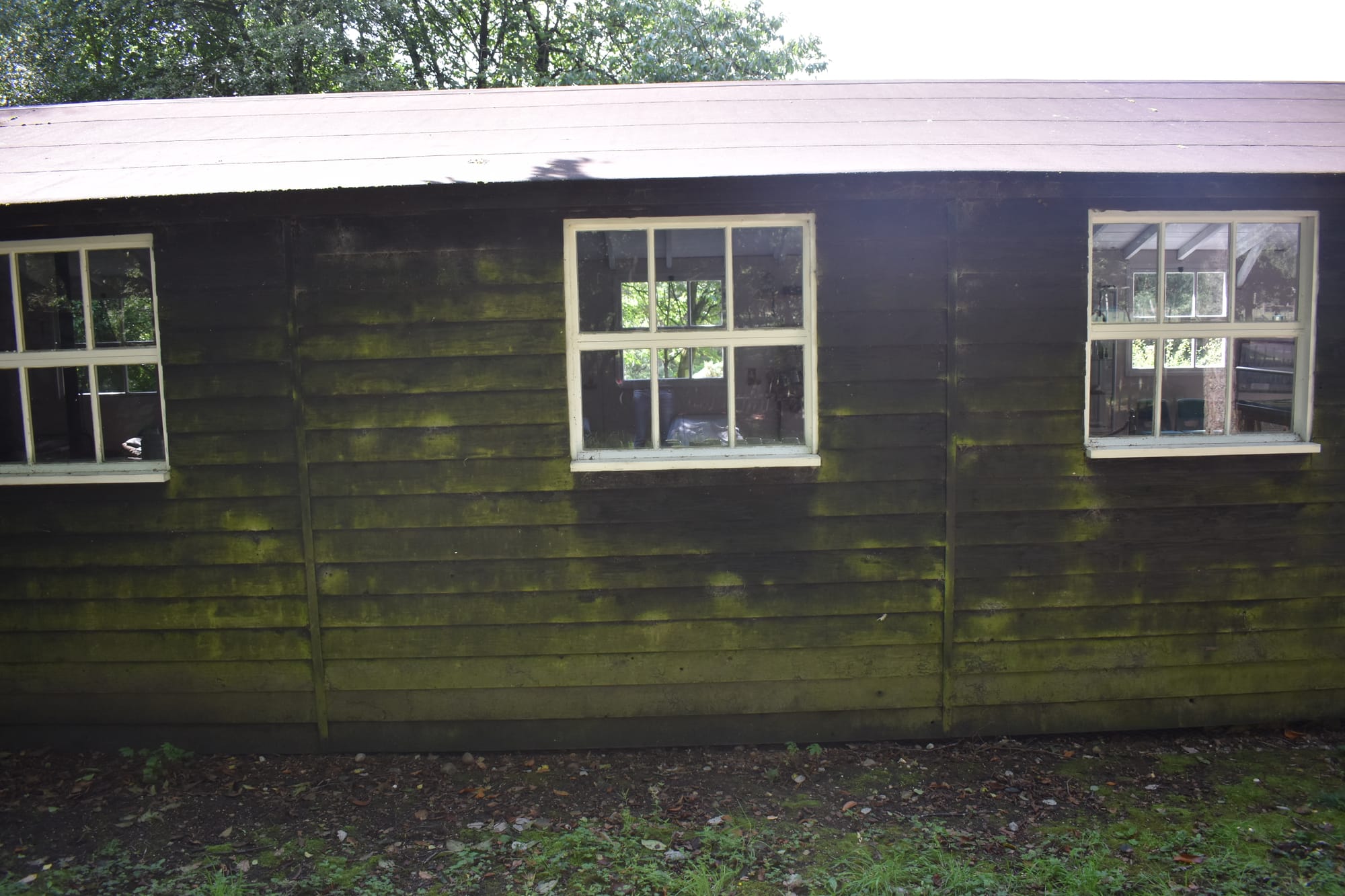
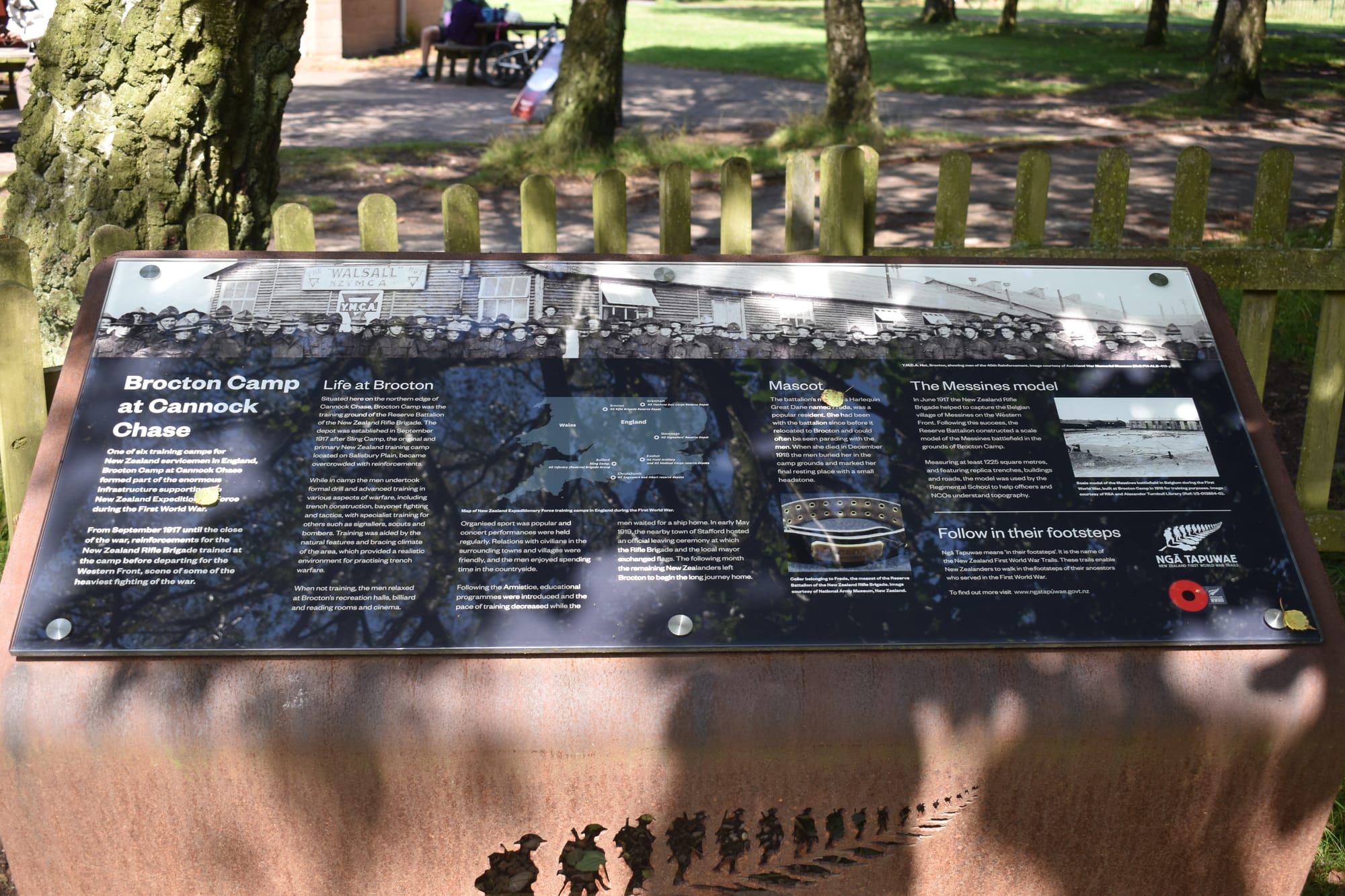 The First World War Hut
The First World War Hut
After we had seen the hut, we did in fact manage to find the right road to the German War Cemetery. As you arrive, there is in fact a Commonwealth War Cemetery, which is visible from the road. We parked here and then walked down the road through the woods for about half a mile to arrive at the actual German War Cemetery. It is a strikingly peaceful and sombre spot, in a small valley surrounded by woodland and heathland. Whether it was the British Government or the German Government who chose the land, they picked a beautiful and appropriate spot. I have seen German War cemeteries near to Ieper, and they tend to be a bit heavy and overly austere, perhaps since they were constructed in the 1920s or 1930s.
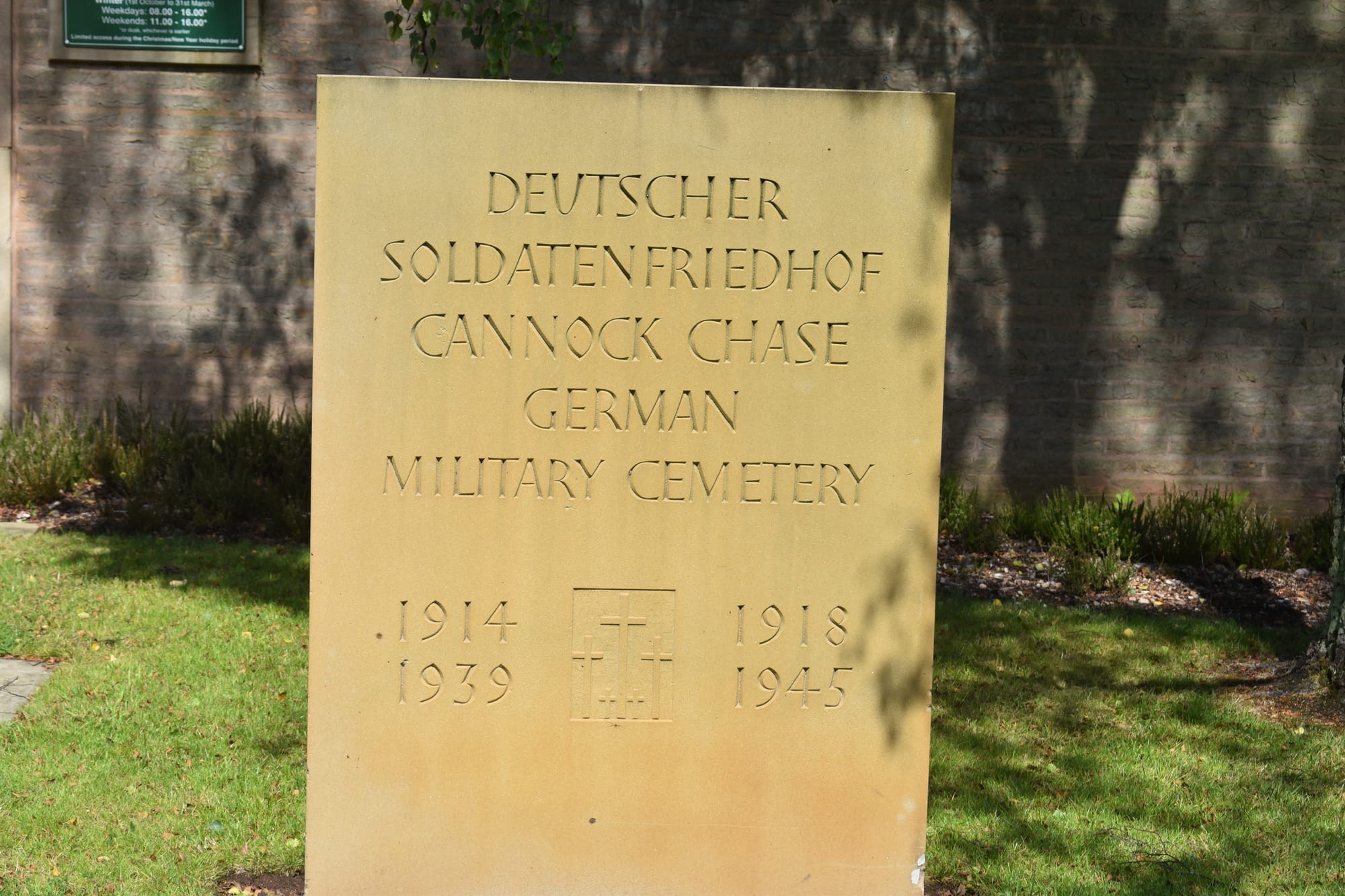 German Military CemeteryThe German War Cemetery is different; it looks very similar to the Commonwealth Cemeteries apart from the different colour of the headstones. In August, all of the graves are surrounded by purple heather, which adds to the overall effect. As you leave the entrance building on the East Terrace, there are four mass graves for the crews of German Zeppelins, which were either shot down or crashed in Southern England in 1916 and 1917. The crews were originally buried near to the sites where they crashed and then during the 1960s they were exhumed and bought to Cannock Chase.
German Military CemeteryThe German War Cemetery is different; it looks very similar to the Commonwealth Cemeteries apart from the different colour of the headstones. In August, all of the graves are surrounded by purple heather, which adds to the overall effect. As you leave the entrance building on the East Terrace, there are four mass graves for the crews of German Zeppelins, which were either shot down or crashed in Southern England in 1916 and 1917. The crews were originally buried near to the sites where they crashed and then during the 1960s they were exhumed and bought to Cannock Chase.
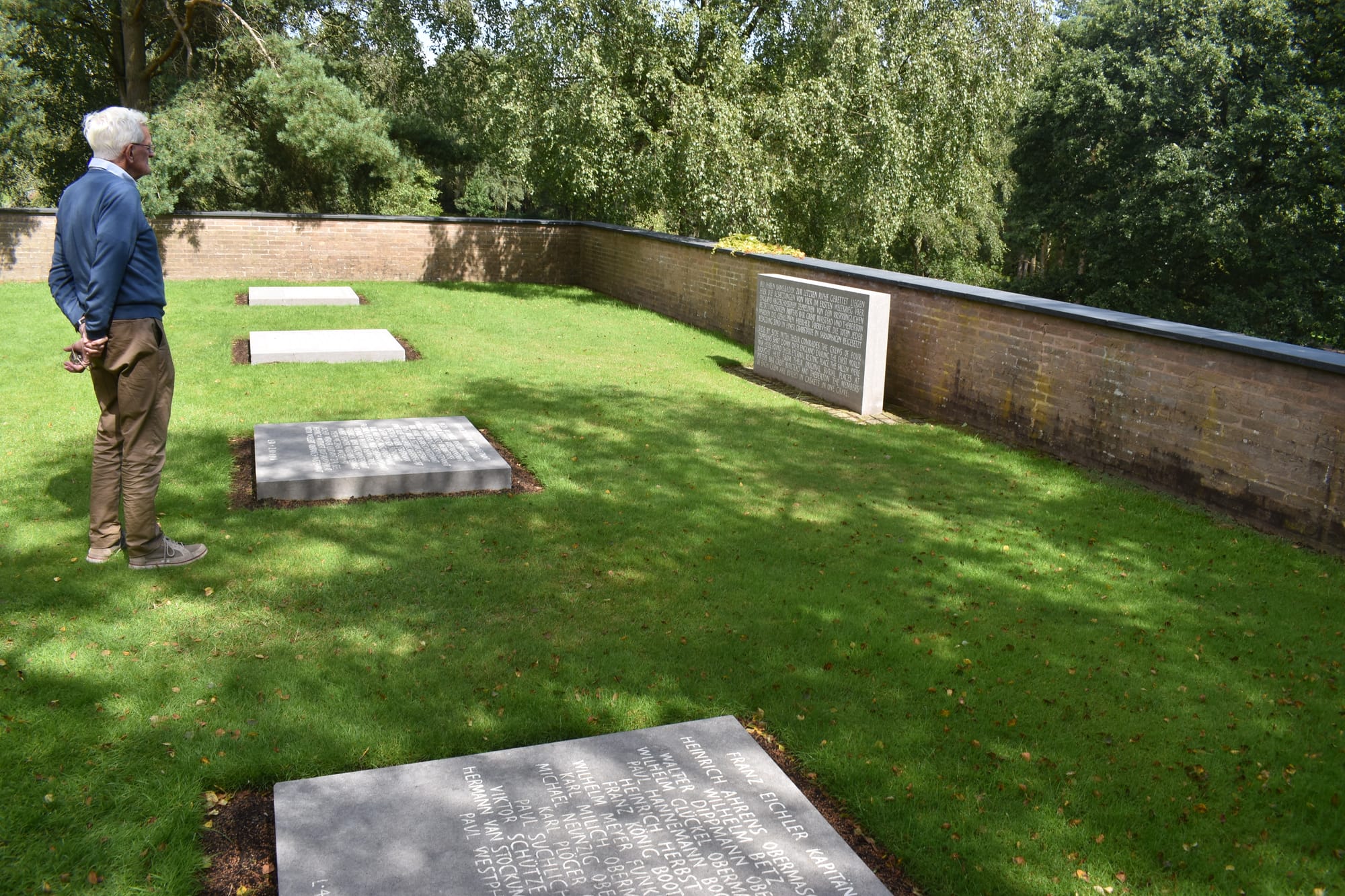 The East Terrace
The East Terrace
The part of the cemetery nearest to the entrance contains the World War 2 burials, it is rather touching to see a fresh bunch of flowers on a Second World War Grave, and clearly, there are still Germans who come to remember their grandfathers or fathers whose last resting place is in British soil. To get to the First World War graves you need to walk down through those from the Second World War and up the other side of the valley.
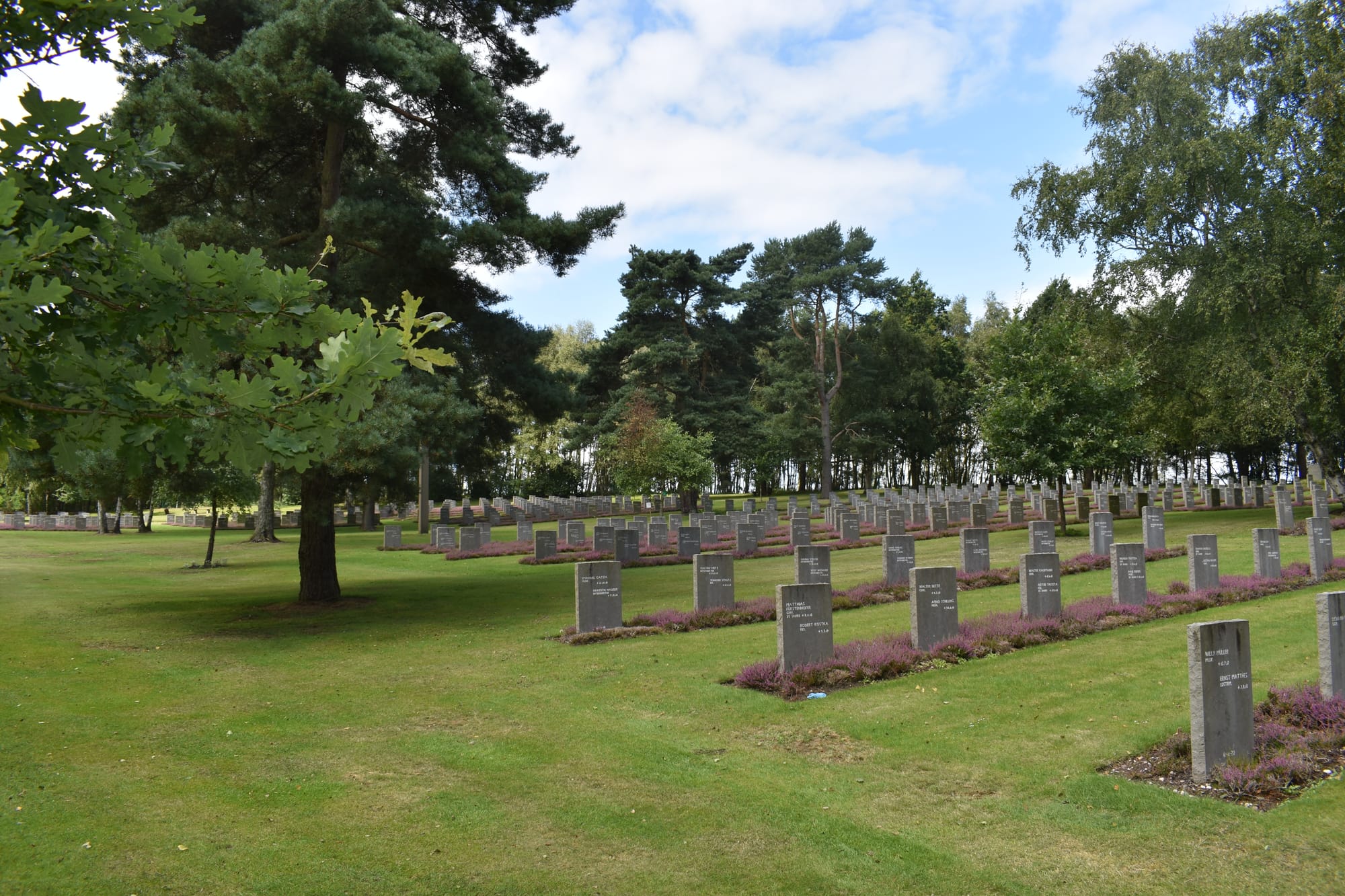 The First World War Graves
The First World War Graves
The geography of the First World War graves at first appears a bit random, civilian internes who died in Britain lie alongside German soldiers, aviators and sailors apparently at random. However, it is not random in any way. All the clusters of graves come from different cemeteries in the UK. Sailors originally buried in Scotland; Zeppelin and bomber crews originally buried near to where they were shot down or crashed in the South East of England, and soldiers who died in prison camps dotted around the whole of the UK. If you have an interest in any particular aspect, it is worth consulting the online records from of the Commonwealth War Graves Commission to find the exact plot number and row for particular graves. We find our Peak Dale prisoners. They are all together on the upward slope of the valley in plot. The headstones are inscribed with two or three names and are surrounded by the purple heather. All the names that I looked up in the International Red Cross database and which became familiar to me as I tried to find out more about them are all here together. Richard Alexander, Paul Lux, Paul Kurzke and all the others – they are all here. They lived together, quarried stone together in Peak Dale, then the Spanish Flu took them and they never made it home. So here they are, all together again in a quiet and beautiful part of England, which is now forever Thuringia or Bavaria or some other region of Germany.
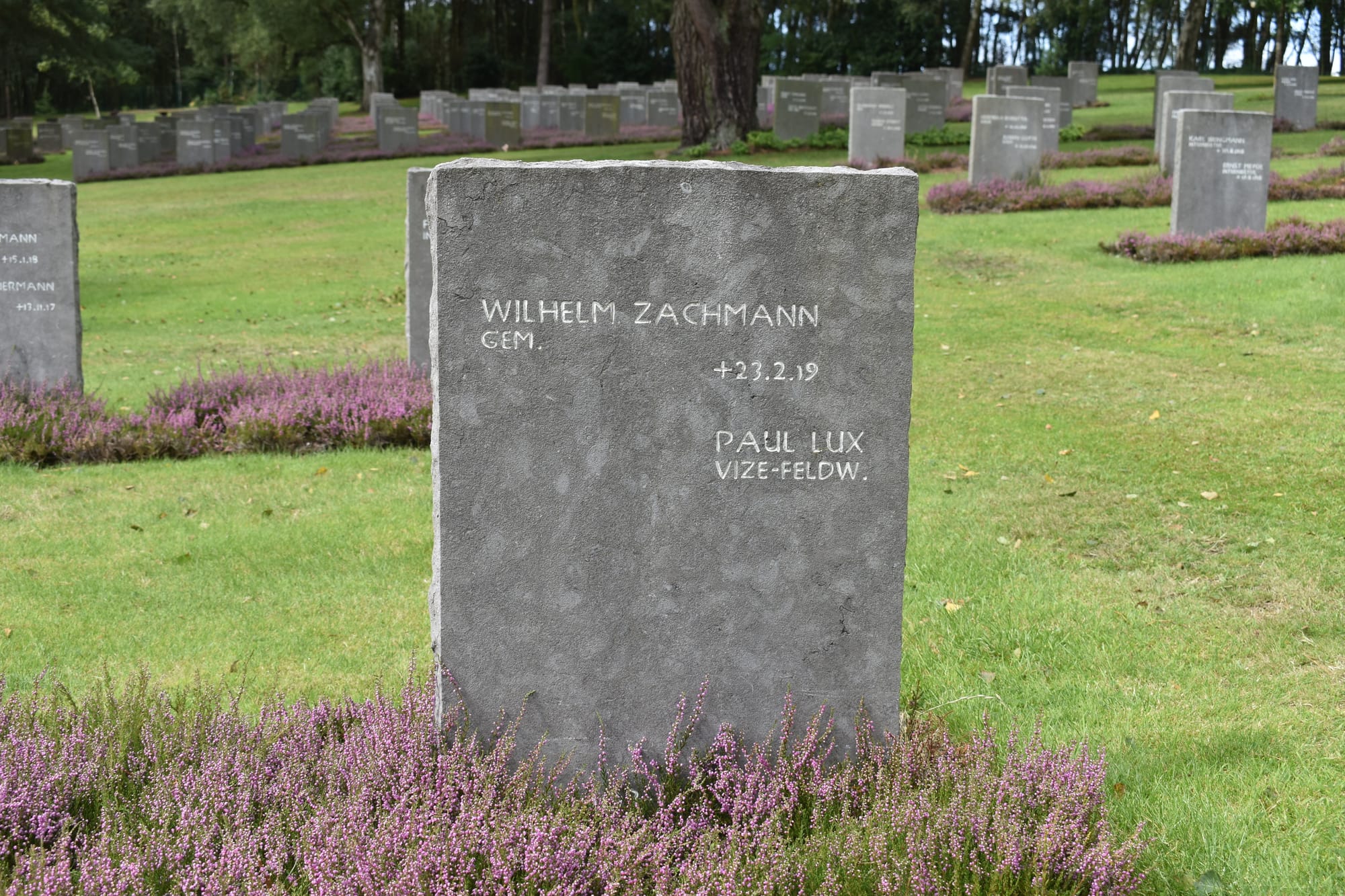 Two of the Peak Dale POWs
Two of the Peak Dale POWs
The striking thing about the cemetery is the number of prisoners who died in 1918 and 1919. There are earlier dates of death for the shot down aircrew, the drowned sailors or the unfortunate soldiers who died of battlefield wounds in a countrywide network of military hospitals- but the very large majority of those buried were victims of the 1918-1919 Spanish Influenza Pandemic that swept through the crowded POW camps like a Pale Horse. The German War Cemetery made me feel very proud of the UK. Clearly, the CWGC tends immaculate war graves for the British and Commonwealth fallen across the battlefields of Flanders and elsewhere in the world and rightly so. However, the immaculate and well-tended cemetery for enemy combatants who died on British soil and the handful of respectful visitors wandering around, gives credit to understated and perhaps now lost, British sense of decency.
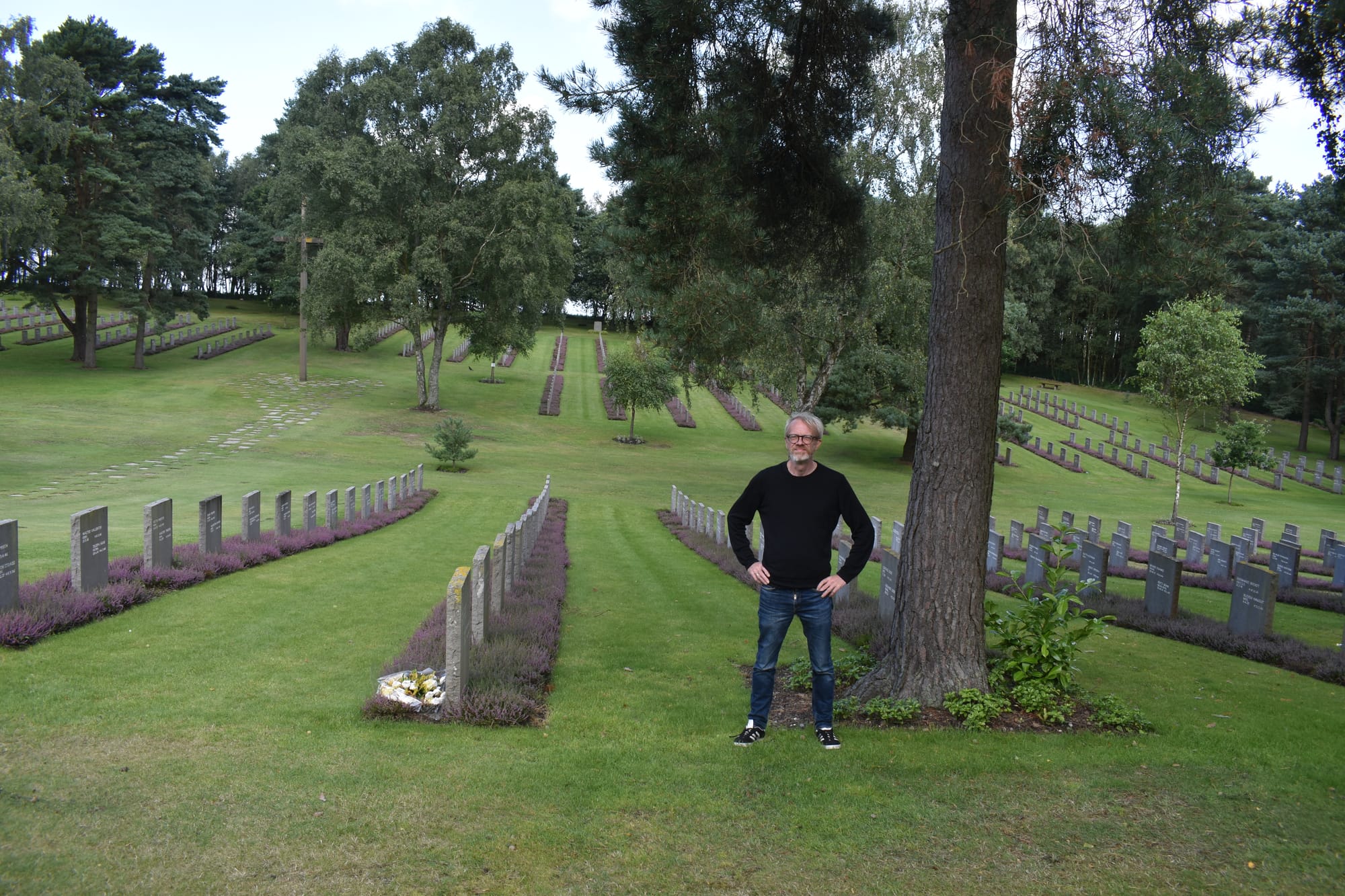 The valley
The valley
I think we have had enough of sombre, so we head off for something to eat. We find the Springslade Lodge and I can heartily recommend there homemade Steak and Kidney with chips and perfectly cooked vegetables. Yes, it was clearly homemade and sorry I asked in advance whether it was. Replenished by that, we return to the Buxton Area to wrap up the day in Ladmanlow. Ladmanlow is right on the edge of Buxton with majestic views of the moorlands in one direction and over Grinlow and Solomon’s Temple in the other. It was here in the long hot summer of 1918, that father first noticed the outlines of some buildings through the dried out grass and started this research. . We know much less about the Ladmanlow Camp than we do about Peak Dale, certainly we lack the first hand report of Dr de Sturler of the German interest section of the Swiss Legation , also since the death rate at Ladmanlow seems to have been much lower during the Spanish Flu we know less about the prisoner identities.
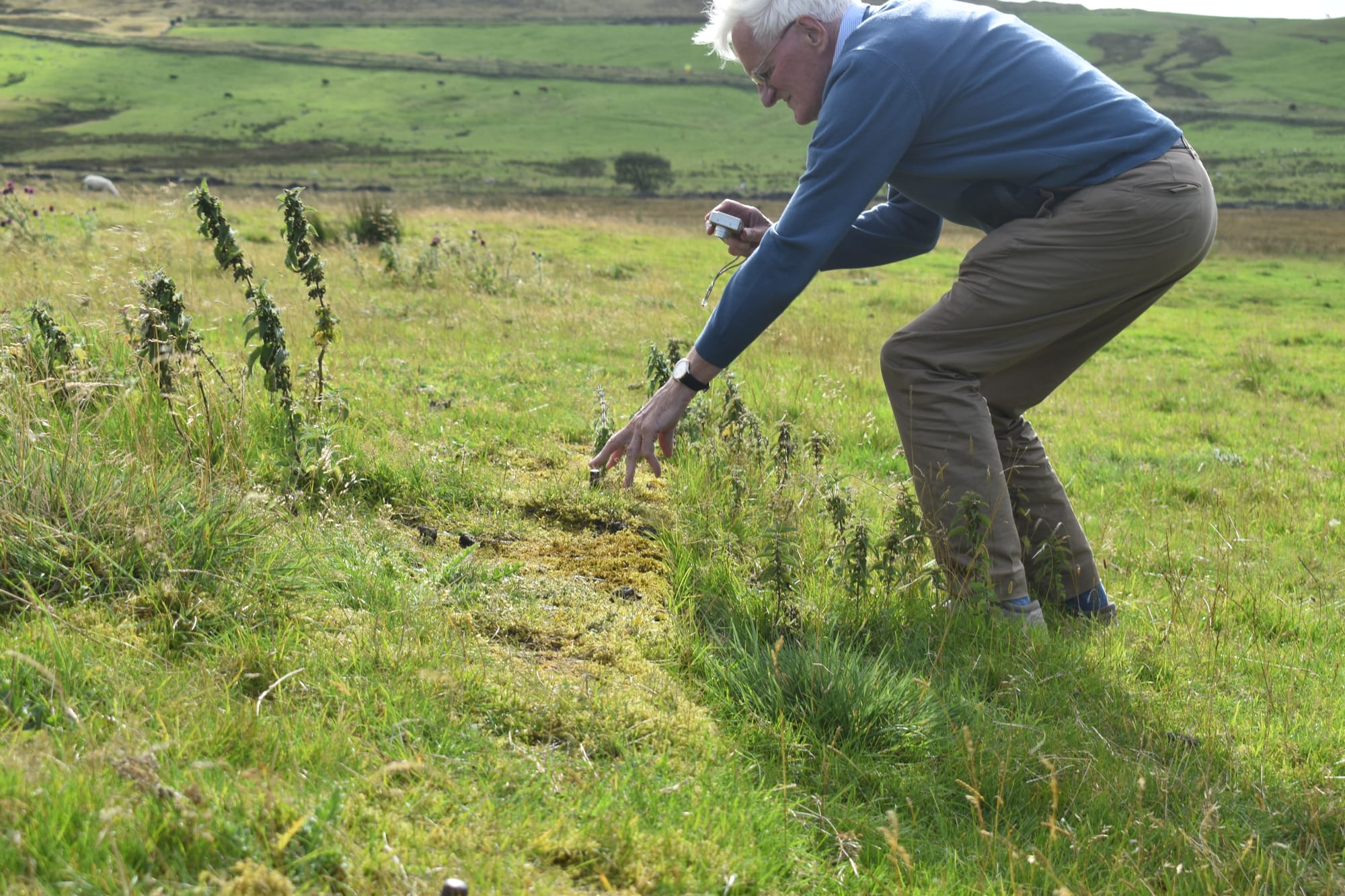 Ladmanlow Camp
Ladmanlow Camp
On the other hand, the site at Ladmanlow is so much better preserved than Peak Dale. There at the far boundary of the prison camp, you can see the concrete foundations f a prison hut. I try to measure the distance with my feet, it is now windy and this proves quite difficult- anyway I think it approximates to about 60 ft. by 15 ft. – perhaps it was one of the smaller huts. Then, I spot something. Sticking up from the reinforced concrete, which forms the foundation, there are a series of bolts- probably between a half and 6/8 inch in diameter. Clearly, this was where the wooden floor of a Type 19 hut (or equivalent) was bolted into the foundations. Well it was hardly Schliemann finding Troy, but I was quite pleased with my minor discovery. The other well preserved part of the archaeology of the site are a series of reinforced concrete squares with a hole in the middle, we suspect from the location that these were either the bases for fence posts or floodlights. From the size and location, I suspect floodlights would be more likely. I find the Ladmanlow site to be splendid, it is more open and exposed than Peak Dale, but with some terrific views.
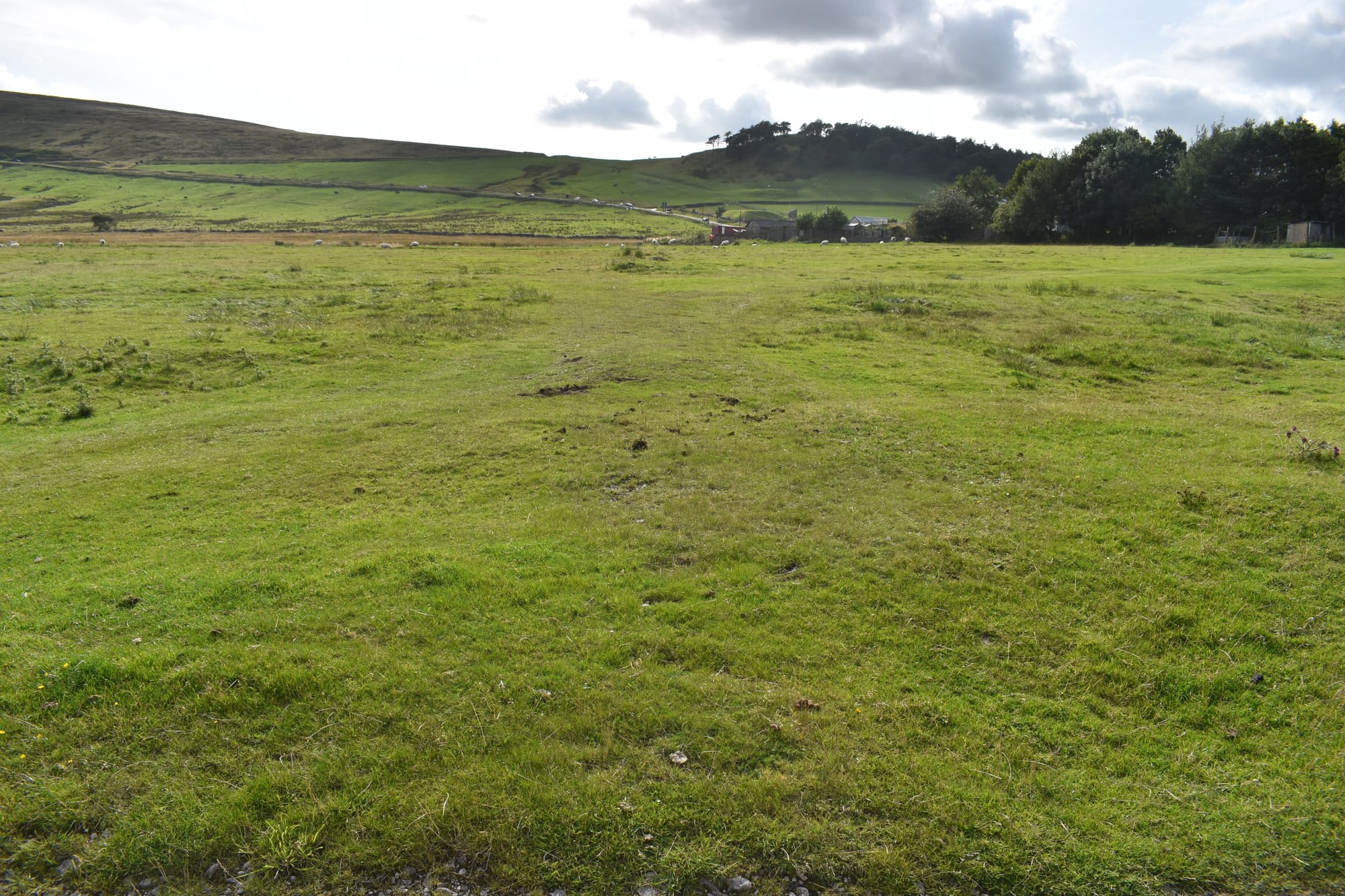 View from Ladmanlow Camp
View from Ladmanlow Camp
It has been a good couple of days exploring these sites, despite the rain and the low temperatures. Both sides are different, Ladmanlow is better preserved and in a spectacular location, yet we do not know so much about is inhabitants. Although at Peak Dale, there is nothing left of the camp but the outline, the details we unearthed from Dr de Sturler’ s report and the records of the individual prisoners bring the place much more vividly to life. In the end, the empty plots in the graveyard at Peak Dale lead us to the immaculate memorial valley at Cannock Chase to close the story.